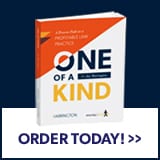There is no single path to a successful law practice. Over time, paths become blocked and new ones emerge. What worked 10 years ago may not work today. What works for some will not work for others. It’s said business development is a relationship game. That’s true, and likely always will be. But the manner in which meaningful, beneficial client relationships are formed and sustained is constantly evolving. Technical proficiency is table stakes. Today, more is required. This is a column about how lawyers and law firms can gain a competitive advantage and build an interesting, profitable practice. Much ink has been spilled, and many keystrokes logged, on the topic. Over the next 12 months this column will attempt to blaze some new ground by mapping out a path — not for everyone, but for those ready and willing to think differently — toward sustainable success.
There Are Simply Four Steps on This Path
There are four steps involved, and each will be addressed in greater depth in the coming months.
1. Choose an expertise. Think narrow. Narrower. Differentiating yourself as an expert in a narrow field is not difficult — it’s not about what you do, it’s about what you don’t do. But it requires courage. The courage to let go of the misguided notion that the more options you provide to the marketplace, the more opportunities will present themselves to you. The world does not need more full-service, general practitioner lawyers and law firms. What is needed, and what good clients are willing to pay a premium for, is deep knowledge and experience in narrow practices and industries. As Herbert Bayard Swope (I had to look him up, too) wisely noted, “I cannot give you the formula for success, but I can give you the formula for failure — which is: Try to please everybody.” Differentiation is about being an expert. It’s about specializing.
2. Develop a brand story. Once you’ve staked out an area of expertise, it is necessary to articulate and share the value of the services and solutions you provide. You need to develop a compelling brand story. To be compelling, it must be bold, unique and authentic. Bold enough to be interesting, unique enough to set you apart, and authentic enough for you to live up to. The more narrowly you define your expertise in Step 1, the more effectively you can develop a brand narrative in Step 2. Large, “full-service” firms that are structured similarly, offer similar services and serve similar markets and industries have difficulty — with good reason — developing a brand story that convinces an audience that they are different in any meaningful sense. That’s not to say it’s impossible, or that some don’t do it extremely well, but it’s hard. A narrowly focused practice, on the other hand, can move past generalities, hyperbole and embellishments and develop a powerful brand narrative that draws notice.
3. Refine your brand experience. Telling clients and prospective clients what to think about you (Step 2) is only half of the equation. Equal, if not more, attention must be focused on creating an authentic brand experience, where your brand speaks for itself through its interaction with clients. Okay, what does this mean in the real world? Most clients cannot distinguish between good and great work product, but all clients can distinguish between a lawyer who returns calls and responds to emails in a timely fashion and another who doesn’t; one who writes clearly and another whose communication is filled with jargon and legalese; one whose receptionist is pleasant and reception area is aesthetically pleasing, and another whose staff is rude and workspace is cluttered; and one who proactively counsels and another who is reactive. From the start of a pitch, to the conclusion of a matter, lawyers need to create a client experience that makes clients want more. Brand messaging can be knocked off — that’s a big reason why most firms look and sound so similar. But authentic brand experiences cannot.
4. Do content marketing. The attorney who executes Steps 1, 2 and 3 really well will experience an uptick in market awareness and new business opportunities. But over time momentum will slow, inertia will take hold, and there will be a reversion to the mean. Selling is still required to sustain and expand existing relationships, and to develop new ones. But rest easy, this model does not require cold calling, glad handing and small talk. At least not in the traditional sense. Implicit in Step 1 is the principle that consumers of legal services desire, above all else, expertise. Unless expertise can be conveyed and validated through referral or reputation, it must be demonstrated through thought leadership expressed in the marketplace of ideas (i.e., content marketing). Experts write. They write to inform, they write to engage and they write to attract. They write to position themselves as the “go-to” person with respect to a particular issue or topic. As a consequence of their writing, they build relationships of trust and loyalty with readers without ever necessarily interacting or engaging with them directly. Over time, when a need or opportunity arises, lawyers who write can shift a relationship from one of writer/reader to that of attorney/client. Writing is selling.
Saying No to Fear-Based Marketing
Differentiating yourself is not easy. It takes hard work and courage. You can hardly blame those who choose to follow a well-trod path and “play it safe.” The forces of commoditization in the legal industry are powerful, and most lawyers and law firms look, act and do business in an almost indistinguishable manner. This tendency is largely driven by fear. Fear of seeming different. Anxiety about being perceived as unprofessional. Angst about missing opportunities.
But by embracing change, and bucking the status quo, you have the power to create an interesting and profitable practice that makes you indispensable, rather than expendable, in the minds of clients. You can go from being one of many to one of a kind.
Jay Harrington is co-founder of Harrington Communications, where he leads the agency’s Brand Strategy, Content Creation and Client Service teams. He also writes weekly dispatches on the agency’s blog, Simply Stated. Previously, Jay was a commercial litigator and corporate bankruptcy attorney at Skadden, Arps, Slate, Meagher & Flom and Foley & Lardner. He has an undergraduate degree in journalism and earned his law degree from the University of Michigan Law School.
ONE OF A KIND:
A Proven Path to a Profitable Law Practice
Practical advice for building a more profitable practice. Almost every lawyer wants to command higher rates and attract more clients. But many are stuck pursuing ineffective strategies. Others don’t even know where to start. In his new book, lawyer-turned-legal marketer Jay Harrington lays out a path for lawyers to build a profitable practice.


















